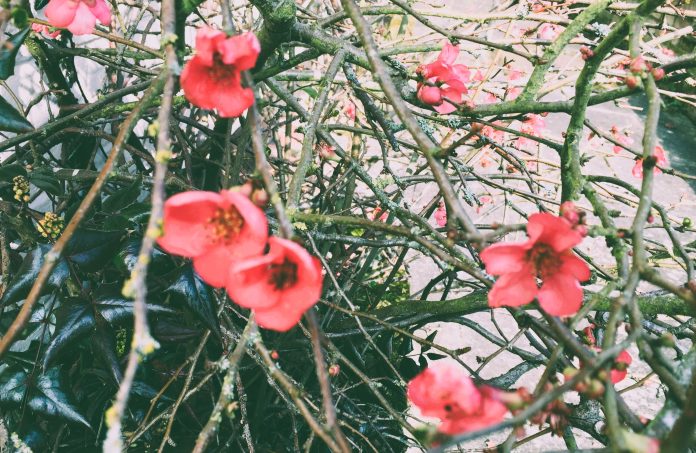Chaenomeles, commonly known as flowering quince, is a stunning addition to UK gardens, renowned for its early blooms and decorative fruits. These hardy shrubs are versatile, low-maintenance, and bring colour and structure to the garden throughout the year. Here’s how to grow and care for Chaenomeles in the UK.
Why Grow Chaenomeles?
- Vibrant Blooms: Chaenomeles flowers from January to April, often when few other plants are in bloom, in shades of red, pink, orange, or white.
- Decorative Fruits: Small, apple-like fruits ripen in September and October and are perfect for jelly-making.
- Hardy and Resilient: Tolerates frost, urban conditions, and a range of soil types.
- Versatility: Suited to growing as a hedge, wall-trained specimen, or freestanding shrub.
The fruits of Chaenomeles (flowering quince) are generally not poisonous to humans or animals. However, they are very hard and astringent when raw, making them unpleasant to eat straight from the plant.
Key Considerations for Chaenomeles Fruits:
- Edibility:
- Chaenomeles fruits are often used for making jellies, jams, and marmalades due to their high pectin content.
- Cooking is essential to soften their texture and reduce their tartness.
- Misinterpretation:
- Chaenomeles fruits are sometimes confused with fruits from unrelated plants like Quercus (oak) or other plants with potentially toxic seeds or fruits.
- While the fruits are safe, consuming seeds in large quantities from any member of the rose family (Rosaceae) could pose a risk due to small amounts of cyanogenic compounds (as with apple seeds). However, the quantity in Chaenomeles is negligible and rarely causes concern.
- Toxicity to Animals:
- There is no evidence to suggest Chaenomeles fruits are toxic to common pets or wildlife. Birds and animals often eat the fruits without issues.
In summary, Chaenomeles fruits are safe and can be enjoyed in culinary preparations, but they must be cooked to make them palatable.
Choosing the Right Variety
There are three main species of Chaenomeles:
- Chaenomeles japonica: Compact and perfect for smaller spaces.
- Chaenomeles speciosa: A larger shrub, ideal for hedges or wall-training.
- Chaenomeles x superba: A hybrid offering a variety of sizes and colours.
Popular cultivars include:
- ‘Crimson and Gold’: Deep red blooms with golden stamens.
- ‘Geisha Girl’: Delicate peach-pink flowers.
- ‘Jet Trail’: A low-growing, white-flowered variety.
Growing Conditions
- Location:
- Chaenomeles thrives in full sun but will tolerate partial shade.
- South- or west-facing walls enhance flower production.
- Soil:
- Prefers well-drained soil but adapts to clay and chalk.
- Enrich planting areas with compost or organic matter.
- Shelter:
- While hardy, protecting blooms from strong winds helps maintain their beauty during January to April.
Planting Chaenomeles
- Timing:
- Plant bare-root specimens between November and March.
- Container-grown plants can be added to the garden at any time of year, avoiding frost and drought conditions.
- Preparation:
- Dig a hole twice the width of the root ball and slightly deeper.
- Add organic matter to the planting hole to improve soil quality.
- Planting:
- Place the plant at the same depth it was in its container or nursery.
- Backfill with soil, firm gently, and water thoroughly.
Care and Maintenance
- Watering:
- Water young plants regularly during their first year.
- Once established, Chaenomeles is drought-tolerant but benefits from occasional watering in dry periods, especially from May to September.
- Feeding:
- Apply a balanced fertiliser in March or April to support healthy growth and flowering.
- Mulch annually in March to retain soil moisture and suppress weeds.
- Pruning:
- Prune lightly after flowering in April or May to shape the plant.
- Remove dead, damaged, or crossing branches in February before new growth begins.
- Training:
- For wall-trained specimens, tie new shoots horizontally to supports to encourage flowering.
Common Pests and Diseases
Chaenomeles is largely trouble-free but may encounter:
- Aphids: Treat infestations with soapy water or an organic insecticide.
- Fireblight: This rare bacterial disease causes wilting. Prune infected parts immediately and sterilise tools to prevent spread.
Propagation
- Cuttings: Take softwood cuttings in June or hardwood cuttings in November.
- Layering: Bend a low-growing branch to the ground in April or May, secure it, and cover it with soil. Roots will form by the following spring.
Seasonal Highlights
- January to April: Bold flowers brighten the garden when little else is in bloom.
- May to August: Glossy green foliage provides structure and a lush backdrop.
- September to October: Fruits ripen, adding a decorative touch and culinary possibilities.
- November to December: Bare branches give an architectural element to winter gardens.
Chaenomeles is a reliable and rewarding shrub for UK gardeners. Its early flowers herald the end of winter, while its autumn fruits and architectural form provide interest throughout the year. Whether used as a hedge, wall-trained shrub, or freestanding plant, Chaenomeles is an easy-to-grow favourite that brings beauty to any garden.




